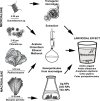Use of micro and macroalgae extracts for the control of vector mosquitoes
- PMID: 37842039
- PMCID: PMC10569164
- DOI: 10.7717/peerj.16187
Use of micro and macroalgae extracts for the control of vector mosquitoes
Abstract
Mosquitoes are one of the most dangerous vectors of human diseases such as malaria, dengue, chikungunya, and Zika virus. Controlling these vectors is a challenging responsibility for public health authorities worldwide. In recent years, the use of products derived from living organisms has emerged as a promising approach for mosquito control. Among these living organisms, algae are of great interest due to their larvicidal properties. Some algal species provide nutritious food for larvae, while others produce allelochemicals that are toxic to mosquito larvae. In this article, we reviewed the existing literature on the larvicidal potential of extracts of micro- and macroalgae, transgenic microalgae, and nanoparticles of algae on mosquitoes and their underlying mechanisms. The results of many publications show that the toxic effects of micro- and macroalgae on mosquitoes vary according to the type of extraction, solvents, mosquito species, exposure time, larval stage, and algal components. A few studies suggest that the components of algae that have toxic effects on mosquitoes show through synergistic interaction between components, inhibition of feeding, damage to gut membrane cells, and inhibition of digestive and detoxification enzymes. In conclusion, algae extracts, transgenic microalgae, and nanoparticles of algae have shown significant larvicidal activity against mosquitoes, making them potential candidates for the development of new mosquito control products.
Keywords: Extract; Larvicidal; Macroalgae; Microalgae; Mosquito.
©2023 Tufan-Cetin and Cetin.
Conflict of interest statement
The authors declare there are no competing interests.
Figures
Similar articles
-
Anti-dengue potential and mosquitocidal effect of marine green algae-stabilized Mn-doped superparamagnetic iron oxide nanoparticles (Mn-SPIONs): an eco-friendly approach.Environ Sci Pollut Res Int. 2024 Mar;31(13):19575-19594. doi: 10.1007/s11356-024-32413-y. Epub 2024 Feb 16. Environ Sci Pollut Res Int. 2024. PMID: 38363508
-
Larvicidal activity of Blumea eriantha essential oil and its components against six mosquito species, including Zika virus vectors: the promising potential of (4E,6Z)-allo-ocimene, carvotanacetone and dodecyl acetate.Parasitol Res. 2017 Apr;116(4):1175-1188. doi: 10.1007/s00436-017-5395-0. Epub 2017 Feb 6. Parasitol Res. 2017. PMID: 28168560
-
Bioprospection for new larvicides against Aedes aegypti based on ethnoknowledge from the Amazonian São Sebastião de Marinaú riverside community.J Ethnopharmacol. 2022 Jul 15;293:115284. doi: 10.1016/j.jep.2022.115284. Epub 2022 Apr 18. J Ethnopharmacol. 2022. PMID: 35447199
-
Bioactive Molecules Derived from Plants in Managing Dengue Vector Aedes aegypti (Linn.).Molecules. 2023 Mar 5;28(5):2386. doi: 10.3390/molecules28052386. Molecules. 2023. PMID: 36903635 Free PMC article. Review.
-
Biocontrol of mosquito vectors through herbal-derived silver nanoparticles: prospects and challenges.Environ Sci Pollut Res Int. 2020 Jul;27(21):25987-26024. doi: 10.1007/s11356-020-08444-6. Epub 2020 May 8. Environ Sci Pollut Res Int. 2020. PMID: 32385820 Review.
Cited by
-
An oral toxicity assessment of a mosquito larvicidal transgenic algae (Chlamydomonas reinhardtii) using adult Zebrafish and its embryos.PLoS One. 2024 Jun 13;19(6):e0303352. doi: 10.1371/journal.pone.0303352. eCollection 2024. PLoS One. 2024. PMID: 38870118 Free PMC article.
-
Assessment of Chlorella vulgaris as a biological control agent against tortoise tick Hyalomma aegyptium (Acari: Ixodidae) in Egypt.Sci Rep. 2025 Aug 15;15(1):29977. doi: 10.1038/s41598-025-13971-8. Sci Rep. 2025. PMID: 40817393 Free PMC article.
-
Toxicity of Macroalgae Extracts to Larvae of the Northern House Mosquito.Life (Basel). 2024 Nov 21;14(12):1527. doi: 10.3390/life14121527. Life (Basel). 2024. PMID: 39768236 Free PMC article.
References
-
- Ahmad R, Chu WL, Lee HL, Phang SM. Effect of ten chlorophytes on larval survival, development and adult body size of the mosquito Aedes aegypti. Southeast Asian Journal of Tropical Medicine and Public Health. 2004;35(1):79–87. - PubMed
-
- Alarcón-Elbal PM, Rodríguez-Sosa MA, Ruiz-Matuk C, Tapia L, Arredondo Abreu CA, Fernández González AA, Rodríguez Lauzurique RM, Paulino-Ramírez R. Breeding sites of synanthropic mosquitoes in zika-affected areas of the Dominican Republic. Journal of the American Mosquito Control Association. 2021;37(1):10–19. doi: 10.2987/20-6953.1. - DOI - PubMed
-
- Alarif WM, Abou-Elnaga ZS, Ayyad SEN, Al-lihaibi SS. Insecticidal metabolites from the green alga Caulerpa racemosa. CLEAN–Soil, Air, Water. 2010;38(5–6):548–557. doi: 10.1002/clen.201000033. - DOI
-
- Ali MS, Ravikumar S, Beula JM. Mosquito larvicidal activity of seaweeds extracts against Anopheles stephensi, Aedes aegypti and Culex quinquefasciatus. Asian Pacific Journal of Tropical Disease. 2013;3(3):196–201. doi: 10.1016/S2222-1808(13)60040-7. - DOI
Publication types
MeSH terms
Substances
LinkOut - more resources
Full Text Sources
Medical


